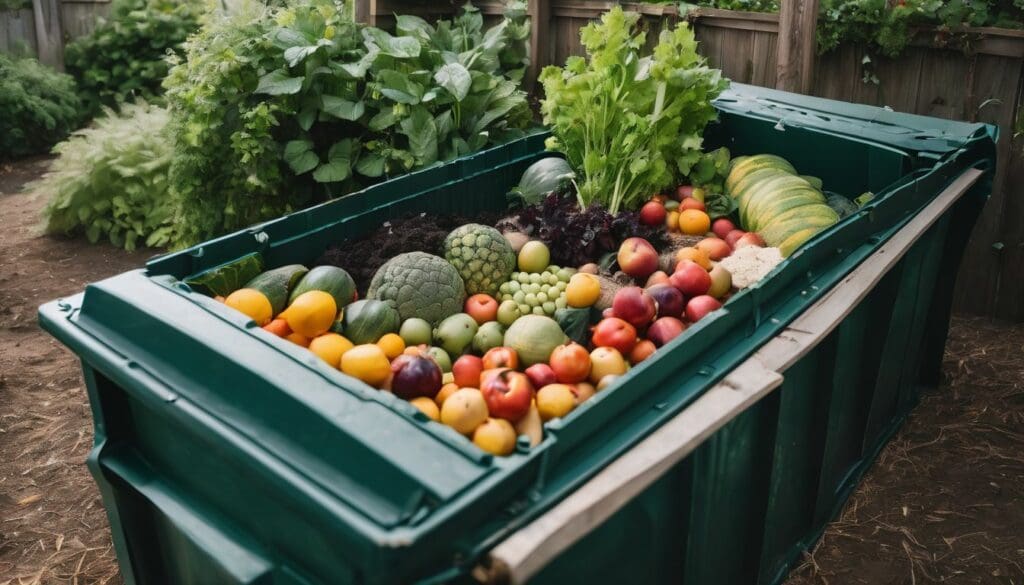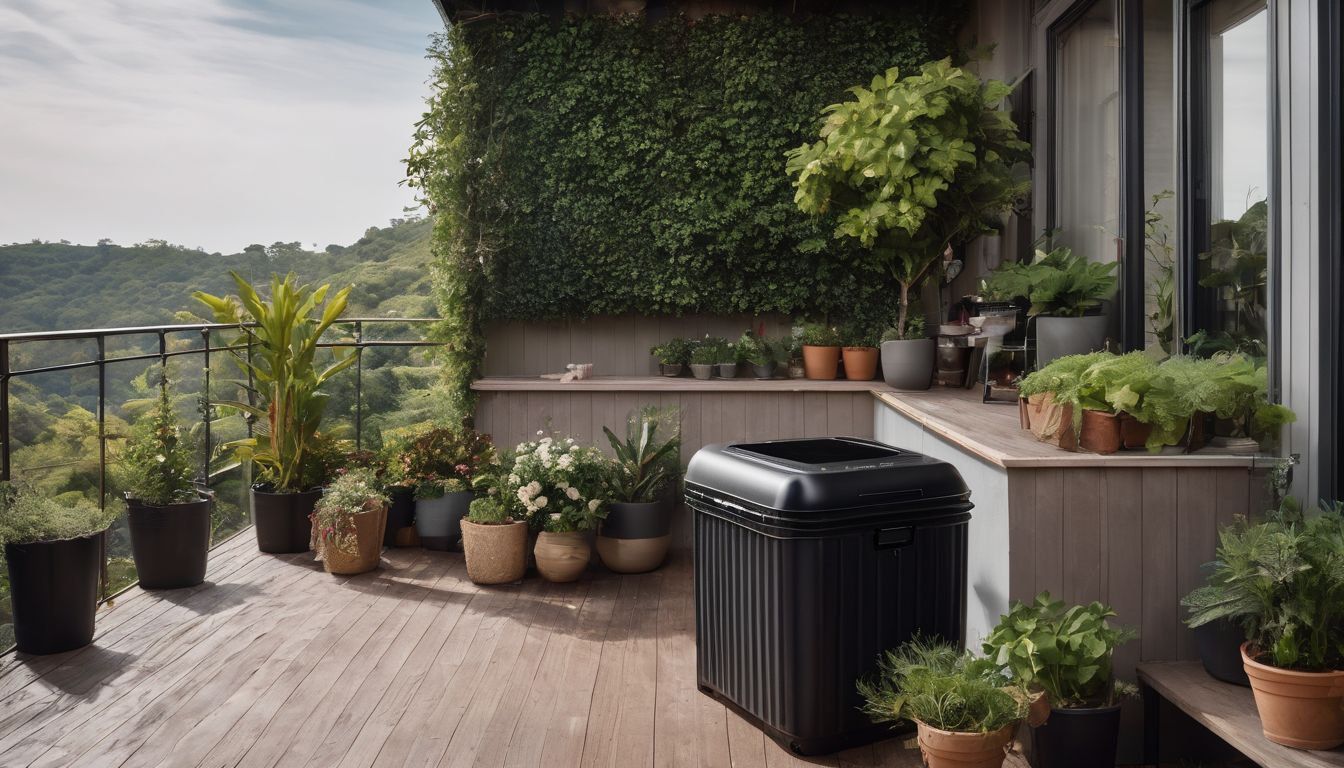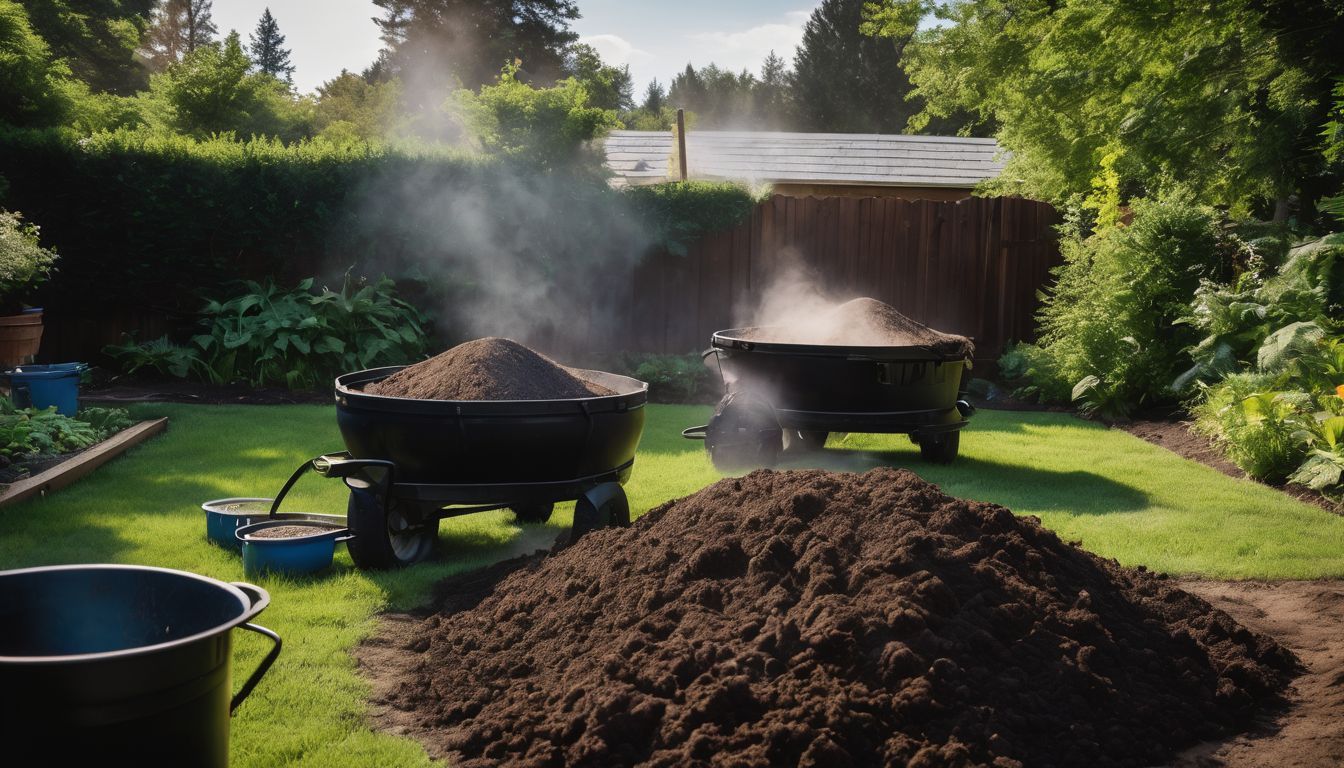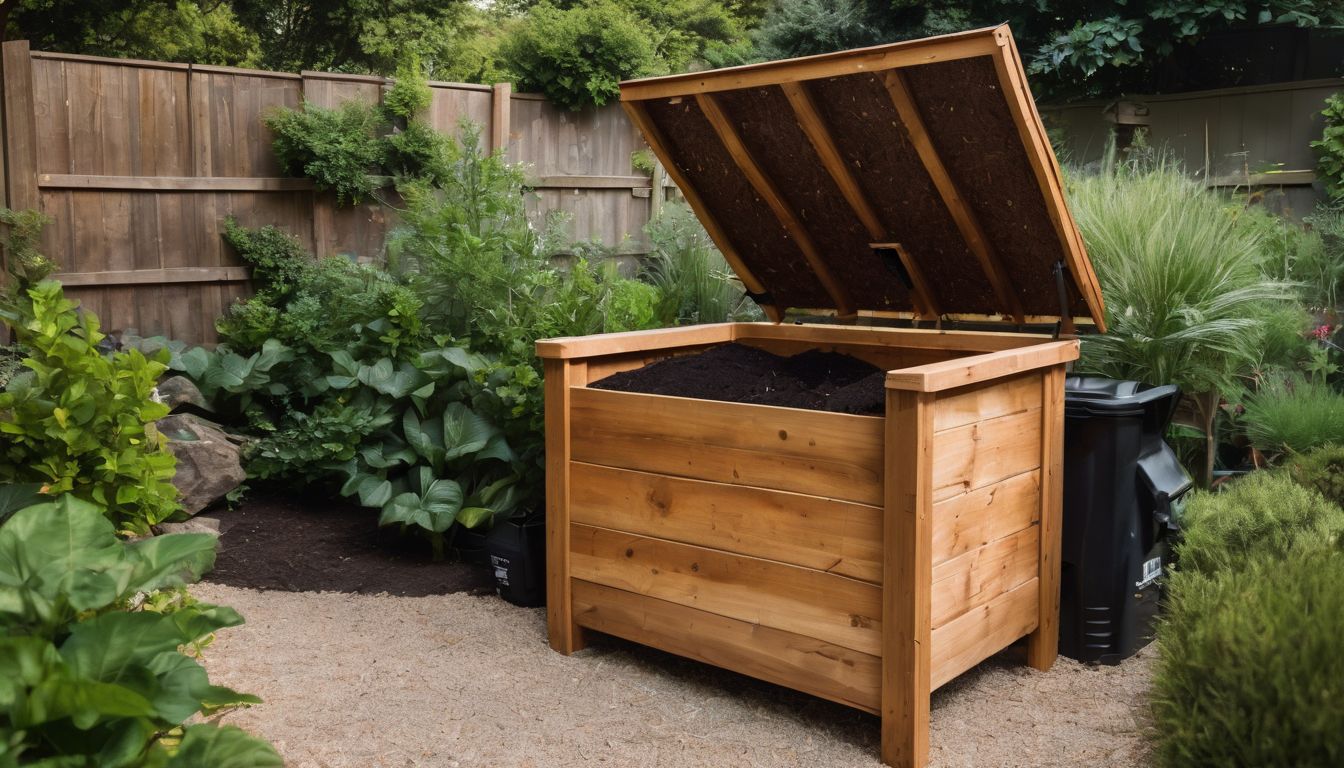Are you tired of throwing away food scraps and yard waste? Composting at home can help reduce your environmental impact. Did you know that composting can divert an estimated 30% of household waste from landfills? In this blog, we will explore what materials can and cannot be composted, helping you create a more sustainable lifestyle. Ready to turn your kitchen and yard waste into nutrient-rich soil? Let’s get started!
Key Takeaways
- Composting kitchen and yard waste can reduce household rubbish by up to 30%.
- Not all waste is compostable; avoid adding meat, dairy, bones, diseased plants and treated wood to your compost pile.
- A good compost requires a carbon to nitrogen ratio of 30:1 and proper layering of ‘green’ and ‘brown’ materials.
- Vermicomposting uses worms to create nutrient – rich compost, suitable for those with limited space.
- Large – scale industrial composting processes significant quantities of organic waste efficiently, reducing landfill use.
What is composting?
Composting is a natural process that recycles organic waste, such as food scraps and garden waste, into a valuable fertiliser for gardens. When you compost biodegradable materials, you help them decompose in an eco-friendly way.
This method of recycling kitchen waste not only enriches the soil but also reduces the amount of green waste sent to landfills. By transforming leftovers from your kitchen and garden into nutrient-rich compost, you are actively participating in sustainable waste management.
Engaging in this form of environmental sustainability supports conservation efforts by turning what would be rubbish into something beneficial for plant life. It’s part of green living practices that contribute positively to our planet’s health.
Next up is understanding which items can go into your compost bin and which should stay out.
Benefits of composting at home
Turning kitchen scraps and garden waste into nutrient-rich soil, composting at home provides a range of advantages. It slashes household waste significantly, reducing the burden on landfills.
By converting organic materials back into fertile earth, gardeners can enhance their soil without chemical fertilisers. This natural cycle bolsters plant growth and helps to sustain a thriving ecosystem right in your backyard.
Home composting serves as an eco-friendly disposal method for decomposable materials, cutting down greenhouse gas emissions from rotting rubbish in landfills. Moreover, it’s a practical example of responsible consumption and waste reduction that aligns with environmental conservation efforts.
Creating compost also saves money otherwise spent on store-bought soil conditioners and promotes a deeper connection with the natural world by engaging individuals in the decomposition process.
What Can Be Composted?
Kitchen scraps, yard waste, paper products, and animal waste are all compostable materials that can be used to create nutrient-rich soil for your garden. Read on to find out more about what you can compost at home!
Kitchen scraps
When composting kitchen scraps, it’s important to focus on fruit and vegetable peelings, coffee grounds, tea bags, and eggshells. These organic materials add valuable nutrients to the compost heap while reducing household waste.
Utilising these kitchen scraps in compost helps enrich the soil and promotes healthy plant growth.
Using a designated container for collecting kitchen scraps makes it easy to transfer them to the compost bin or pile outside. Ensure that meat, dairy products, and oily foods are avoided as they can attract pests and slow down the decomposition process.
Properly managing kitchen scraps is an essential step towards sustainable living practices.
Yard waste
Yard waste, such as grass clippings, leaves, and small branches, can be an excellent addition to your compost pile. These materials provide essential carbon for the composting process.
Shredded yard waste also helps aerate the pile, preventing it from becoming too compacted and allowing air to circulate properly. Additionally, incorporating yard waste into your compost helps divert this organic matter from landfills and reduces methane emissions.
Using a mix of green kitchen scraps and brown yard waste creates a well-balanced compost that enriches the soil in your garden or flower beds. By diverting yard waste from traditional disposal methods, you’re making a positive impact on the environment by reducing greenhouse gas emissions and supporting sustainable practices.
Paper products
Paper products are compostable items that can be added to your compost pile. This includes shredded paper, cardboard, and newspaper. When adding paper products to your compost, tear or shred them into small pieces to help speed up the decomposition process.
Ensure that the paper products are free from any plastic coatings or glossy finishes as these will not break down in the compost. Your eco-friendly waste disposal efforts will benefit from including paper products in your home composting routine.
– Animal waste
Animal waste
Animal waste, such as manure from herbivores like cows, horses, and rabbits, can be composted. These organic materials are rich in nitrogen and important for achieving a balanced carbon-to-nitrogen ratio in your compost pile.
When mixed with carbon-rich materials like leaves or straw, animal waste contributes to the breakdown of organic matter and helps create nutrient-rich soil for gardening and landscaping.
Composting animal waste at home is an eco-friendly way to manage these resources sustainably while reducing the environmental impact of traditional disposal methods. By incorporating animal waste into your composting routine, you can contribute to food scraps recycling and reduce household waste significantly.
This type of household composting supports conservation efforts by diverting organic materials from landfills and promoting ecofriendly waste disposal practices.
What Cannot Be Composted?
Meat, dairy, and bones are not suitable for composting as they attract pests and can cause odours. Additionally, diseased plants should not be added to a compost pile as this could spread diseases to healthy plants.
Meat, dairy, and bones
Meat, dairy, and bones should be avoided in home composting. These items can attract pests and rodents, leading to an unpleasant and unhygienic compost pile. Additionally, the breakdown of these products can release foul odours that may disturb neighbours or cause a nuisance.
Instead, consider disposing of meat, dairy, and bones through other environmentally friendly methods such as anaerobic digestion or industrial composting.
Moving on to “Diseased plants” – let’s explore how certain plant materials can impact your composting efforts.
Diseased plants
Diseased plants should not be composted as they may contain harmful pathogens and diseases that can spread to healthy plants. Instead, it’s best to dispose of diseased plant material through other means, such as burning or burying them deep in the ground away from any garden areas.
This prevents the potential spread of disease while still allowing for eco-friendly disposal.
Moving on to the next section about “Treated wood products”, let’s explore what can and cannot be included in a balanced compost heap.
Treated wood products
Treated wood products, such as pressure-treated lumber and stained or painted wood, should not be composted. These materials may contain harmful chemicals that could leach into the soil and negatively impact the quality of compost.
Due to their synthetic additives, treated wood products are not suitable for eco-friendly disposal through composting. Instead, they should be disposed of through appropriate waste management channels to prevent environmental contamination.
Moving on to “How to Create a Balanced Compost” let’s explore the essential elements needed for successful composting.
How to Create a Balanced Compost
“Balanced compost requires a proper carbon to nitrogen ratio and layering of materials for optimal decomposition and nutrient-rich soil. Learn more about creating the perfect compost mix by reading our full blog post.”.
Carbon to nitrogen ratio
To create an efficient compost pile, aim for a 30:1 carbon to nitrogen ratio. This means adding more “brown” materials such as dried leaves, straw, or cardboard for carbon, and less “green” materials like kitchen scraps or grass clippings for nitrogen.
Achieving this balance provides the ideal environment for beneficial microorganisms to break down organic matter effectively.
Ensuring a proper carbon to nitrogen ratio in your compost will result in nutrient-rich soil amendment that can enhance plant growth and help reduce waste. Next, let’s explore the proper layering of materials to optimise the composting process further.
Proper layering of materials
To achieve a balanced compost, it is important to layer your materials properly. This involves alternating between “green” nitrogen-rich materials such as kitchen scraps and yard waste, and “brown” carbon-rich materials like paper products and animal waste.
By layering these materials correctly, you can create the ideal environment for microorganisms to break down the organic matter into nutrient-rich compost that will benefit your garden.
When building your compost pile, start with a layer of brown material as the base and then add a layer of green material on top. Continue this alternating pattern until you reach the desired height for your compost pile or bin.
Alternative Composting Options
Vermicomposting involves using worms to break down organic materials, while industrial composting facilities handle larger quantities of waste. If you want to learn more about these alternative options, keep reading!
Vermicomposting
Vermicomposting involves using composting worms to break down organic materials into nutrient-rich fertiliser. These specialised earthworms consume food waste, producing a dark, crumbly substance known as vermicast.
This method is an excellent option for those with limited outdoor space and can be done indoors in small bins or containers, making it ideal for urban dwellers seeking sustainable waste disposal solutions.
To ensure success with vermicomposting, it’s important to use the right types of food scraps and bedding materials that won’t harm the worms. Additionally, maintaining proper moisture levels and temperature within the worm bin is crucial for their health and efficient decomposition process.
Industrial composting
Industrial composting facilities are large-scale operations that process organic waste on a commercial level. These facilities use special equipment to heat, turn, and monitor the composting process to produce high-quality compost in a shorter timeframe.
Compostable materials from various sources such as food scraps, yard waste, and compostable packaging can be efficiently processed in these industrial facilities, contributing significantly to eco-friendly disposal and reducing landfill waste.
Composting at an industrial level offers an effective solution for diverting organic waste from landfills and reducing greenhouse gas emissions. By methodically managing the decomposition of organic material through controlled processes, these facilities play a crucial role in sustainable waste management practices while supporting conservation efforts and environmental sustainability.
Conclusion
In conclusion, composting at home offers numerous benefits. Understanding what can and cannot be composted is essential for successful decomposition. By creating a balanced compost and considering alternative options like vermicomposting, individuals can contribute to eco-friendly waste disposal.
Taking simple steps towards responsible yard waste management supports environmental conservation efforts.
FAQs
1. What items are considered compostable materials?
Compostable materials include organic waste such as fruits and vegetables scraps, yard waste like leaves and grass clippings, and other biodegradable items that can be broken down naturally.
2. Can I put all food scraps in my compost bin?
Not all food scraps can be composted. Only eco-friendly disposal items like vegetable peelings, fruit waste, tea bags, and coffee grounds should go into your compost; avoid meats and dairy products.
3. Why is it important to know what cannot be composted?
Knowing what cannot be composted helps you prevent contamination of your pile with non-biodegradable materials that could disrupt the decomposition process or attract pests.
4. How does properly disposing of yard waste contribute to effective composting?
Effective disposal of yard waste ensures only appropriate green matter goes into your compost pile which then decomposes correctly to create nutrient-rich soil for gardens without harming the environment.





